
Sydnordisk
Akademi for Donaldisme : Afdelingen for Donaldistisk Genealogi

by
Dr.don.gen. Asger Pedersen, Dansk Andelogisk Forsknings Institut (DAFI)
1978/2006
Original article written in 1978 and published in DDF(R)appet no. 6-7 in 2005.
English translation by Dr Asger Pedersen in 2006, with pictorial captions by Dr Gjøgsig (SAD).
Table of content:
In
the summer of 1987 I got the idea to make a family tree of the Ducks’
relatives and ancestors, after Frank Madsen had printed a little genealogical
essay and tree in DAFINYT (the Pixilated Artist) no. 3, and I made a
sketch and a few comments to DAFINYT no. 4. In the meantime, I had seen a
few family trees in other donaldistic fanzines and books, and I started to
compare these with each other and with mine.
Grobian
Gans’ book “Die Ducks – Psychogramm einer Sippe” contains the
first tree of the clan that, as far as I know, has been printed in Europe. I
have read in The Barks Collector that a Barks family-tree was made once
in the 1960s (A Fanzine/Disneydom 2), but this I have not seen. Gans has used
the German editions of Disney comics and found 65 different Ducks, 37 of these
are named, therefore 28 is put in to save the continuity. The tree is decidedly
a pioneer study, and besides that it is rather difficult to interpret, it is
also somewhat faulty; but you have to consider that Gans had no access to other
donaldists’ research, and he had access to no original sources, so many of the
trees’ mistakes come from translation. But then, if you study it intensely,
some rather good solutions show up, which I have used too. His tree starts with
4 Scottish ancestors, splits into four branches about 1700, which after 4-5
generations with many empty spaces come together in the three living
generations: Scrooge’s with 13 Ducks, Donald’s with 13, and HDL’s with 7.
Compared to the tree of Grobian Gans, Jon Gisle’s tree in “Donaldismen” is quite simple, even if Gisle had knowledge of “Die Ducks”, his tree has only 35 Ducks of which 7 are unnamed. The tree goes back to Alexander McDuck in ancient Greece, jumps to Scotland A.D. 1400, branches out by A.D. 1700 too, but only in two, which come together in four living generations: Scrooge’s, Donald’s parents’, Donald’s and the ducklings’. Like Gans’ tree, the Gisle tree is a pioneer work, and neither has Gisle used information from original sources, but only used Norwegian editions, which was very usual in donaldistic science in 1973.

The Duck family tree of Jon Gisle.
Then
in Der Hamburger Donaldist no. 7 came an article titled “Die Lücke im
Stammbaum” which treated the apparent missing parents in the Duck family.
There was a little tree of 17 Ducks, with highlight on the closer relations
between the living generations, rather logical, but it later appeared somewhat
faulty.
In
the Swedish NAFS(kuriren) no. 1 Stefan Diös wrote an article about
Gladstone Gander with a little tree that was even more unfortunate. The fanzine Donaldisten
in Norway had in the meantime – well actually before both NAFS(k) and dHD
– become fertile soil for a fruitful discussion about the McDuck family. Donaldisten
no. 13 contained “Genealogiske andestudier” by Kim Bengtsson, which ended
with a tree of 13 Ducks. In no. 14 Bosse Engwall (and Pål Jensen) commented on
this article and contributed with the FOUNDATION STONE of all donaldistic
genealogy: Gladstone’s line in the Carl Barks-story from 1949 “Race to the
South Seas” (MOC 41): »Scrooge
McDuck is my mother’s brother’s brother-in-law!«

In
Donaldisten no. 15 came the breakthrough of methodical donaldistic
genealogy: Dag Erik Tinghaug’s article “Slægt skal følge slægters
gang”, that logically showed the known Ducks’ family relations in a tree of
25 members, and its validity is clear to this day. In Donaldisten no. 20
Tommy Andreasen with no great luck tried to correct and evolve Tinghaug’s tree.
NAFS(kuriren) no. 4 contained an article and a tree, that besides showing
some ancestors that had not been mentioned elsewhere – as an example Scrooge
Shah of Fatcatstan – only showed sign of regression into national-source study
again.
I
now started a systematic registration of family members and ancestors in the
source material I had access to, about 700 issues of Anders And & Co.,
the Danish Donald Duck-magazine, and most of the donaldistic scholarly
literature, and I changed my model as I found more to fit in. After having found
about 100 names in my own sources, I started writing letters to various
donaldists I knew, and asked for help. A column in the fanzine DAFINYT
no. 9, which I by chance had become lay-outer for, and a letter in Der
Hamburger Donaldist no. 18, gave some results, and I could now make a
preliminary family tree that necessarily had to be drawn rather large (A2) to
make enough space.
Like
Tinghaug, I started with the aforementioned foundation-stone, the relation
between Scrooge and Gander, put in Donald, his cousin Della Duck and her kids
Huey, Dewey and Louie. Then I worked backwards in time and put in parents,
grandparents and so on, until I had to stop with Scrooge’s
Great-great-great-grandfather Seafoam McDuck in the 18th century.
Under the before-mentioned registration of ancestors, I had found quite a lot of
Ducks from 2050 B.C. until A.D.
1400, and I put these in the tree, which I had to increase in height. Finally, I
worked out from the stem and put in different uncles, aunts and cousins, whereby
I got the relations of Gus Goose, Ludwig von Drake and Daisy Duck drawn up.
At
first I had hoped that the principal line – which is Scrooge’s male
ancestors – could contain Barks-only characters, but I had to use Ducks from
other American and European sources to get the continuity in shape, and then I
even had to put in some unnamed Ducks.
When
I had registered about 90% of all Danish source material until about 1980, I
estimated that I had all the important family members in my tree, whereas I
surely missed some less important uncles or cousins. But now the problem
occurred to me that none of the comics’ creators, not even Barks, had any
clear notion of how the Ducks’ family relations were, and contradicting
information popped up by greater and greater numbers. By the registration I
included all mentioned relatives, but as an example I found four different
grandfathers of Scrooge: Titus And the Scotsman, Silas Elias the sailor,
Ebenezer von And who in 1870 bought land, where Duckburg now lies, and the gold
digger Pamfilius von And. I had some doubt about how I should solve that kind of
problems, but in the end I decided that it actually was my task as a donaldistic
genealogist to sort, weight and choose between the sources, to make a family
tree at all.
When I made the tree, I used as a guiding principle that the Duck family themselves have information about the clan far back in time, but probably only of the principal line, the Scottish nobles, from whom Scrooge has descended in male line, so where no information is in conflict with it, I have put ancestors with the family name McDuck on this line, which can be followed all the way back to A.D. 946. For most ancestors before or outside this line, the Ducks only have knowledge about them from magic, hypnosis, time-travelling or archaeological excavations.
Of
course, the Ducks have had ancestors as long as there has been Ducks on Earth.
The first named Duck is Scrooge-Shah I of Fatcatstan 2050 B.C.
He escaped with his nephew Donduk and his three grand-nephews, princes of
Fatcatstan, from the capital Dachbad, when it was conquered by the Oriental King
Khan-Khan, who by the help of a magic powder lived in 4000 years and met
Scrooge, Donald and the nephews in the story “King Scrooge the first”
written by Carl Barks and illustrated by Tony Strobl in US 71. We never again
hear of Scrooge-Shah or his nephews, but their descendants must have spread over
the Middle East and Southern Europe.
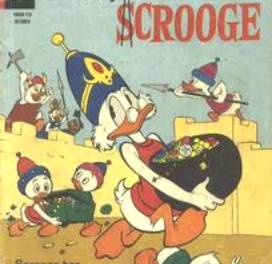
King
Scrooge (or Scrooge-Shah) the First of Fatcatstan was defending his few savings
from greedy hordes in ancient Dachbad around 2050 B.C.
Apparently, not all that much has changed in the intervening 4000 years...
Approximately contemporary with Scrooge-Shah lived Pharaoh Tut-Ank-And, who is mentioned in the story “Papyrus problemer” drawn by Vicar in Anders And & Co 34/1978, and who through the Egyptian dynasties must be an ancestor to Queen Kleop-And-Tra. Another Egyptian pharaoh was the father-in-law of King Solomon (US 19). We get a couple of very uncertain details in the Barks story “Back To Long Ago” (US 16) where Scrooge ponders if he in an earlier life has been »..doorkeeper in the mines of King Solomon...« about 1000 B.C. or »..treasure-guard of King Croesus...« about 550 B.C.


Possible occupations of Scrooge’s ancient ancestors: doorkeeper in the mines of King Solomon and guard of the treasury of King Croesus. Strangely enough, such offices appear more suitable in the humble mind of Scrooge than actually having Solomon or Croesus themselves as forefathers. Perhaps the guarding of the treasures is more important than the mere possession of them?
The historically first information about the Clan McDuck in Scotland is from a time travel that Donald and the ducklings make in a story by Strobl (DD 107). In the time of the Emperor Hadrian about A.D. 125, they prevented an attack form a tribe of wild Scots on the Wall of Hadrian, and these Scots were members of Clan McDuck. Later on, Marco Rota showed how Donald dreamt himself back to the Viking Age, where he as McVillan led the defence of a Scottish castle against the Vikings (AT 277).
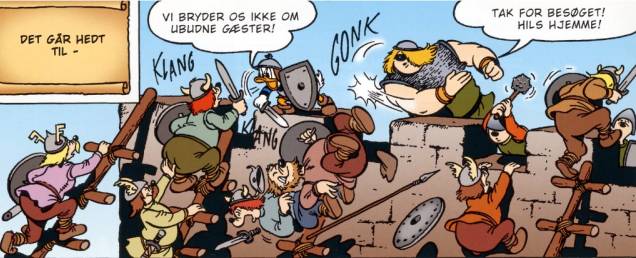
The legendary Commander McVillan tells the Vikings to shove off - with the help of a few good men.
In “The old Castle’s Secret” by Carl Barks (OS 189) five Scottish nobles of the McDuck Clan are mentioned: Sir Eider McDuck, who died in battle against the Saxons in A.D. 946; Sir Quackley McDuck, who walled himself into the treasury in 1057; Sir Roast McDuck, who died of over-eating in the king’s larder in 1205; and his son Sir Swamphole McDuck, who shut the dungeons in 1220. The fifth noble is Sir Stuft McDuck of whom we have no further information. Donald was sent back in time by Strobl to the Middle Ages to discover, how the knight Sir Sooth Duck invented the Duck family-banner in “Flag bragger” (DD 81). In the 15th century Angus the Anvil lived on an old castle in Scotland, whereto Scrooge, Donald and the nephews were hypnotically lifted 500 years into the past, to look for the family jewels and the “Loch Loomis sea serpent” in a story by Bradbury (S 65141). At about the same time, in A.D. 1458, the Clan McDuck built the family castle in Scotland according to Strobl (DD 59).
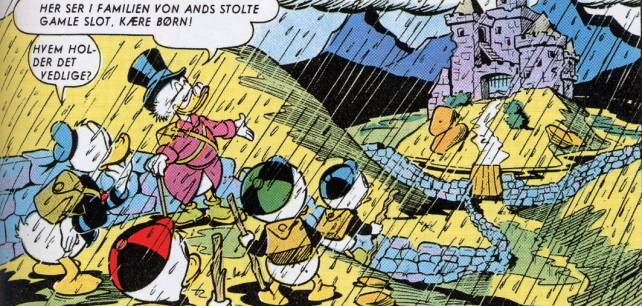
There is nothing like home: McDuck Castle in
Scotland. It has got its own sea serpent and everything!

Joak McAndy taught his fellow Scottish countrymen the value of thriftiness. Before him, Scotsmen allowed themselves the luxurious habit of throwing away used matches, but such decadence all came to an end with McAndy…
December
9th in 1564 the British warship ‘HMS Falcon Rover’ was sunk by
the Spanish navy west of Curacao. Three days earlier Matey McDuck, an ancestor
of Scrooge, and Pintail, Donald’s ancestor, buried a treasure on Moon Island.
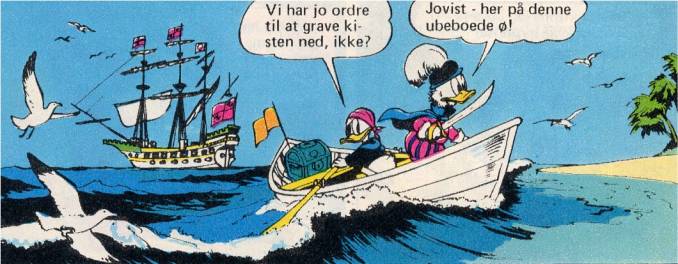
Matey
McDuck and Pintail on their way to Moon Island in 1564. Almost 400 years later,
their descendants Scrooge McDuck and Donald followed in their footsteps - or
wake, rather - to dig up the treasure: a coffin full of potatoes.
Scrooge
and Donald remember this from ancestral memory in the Barks story “Back to
Long-ago” (US 16). A male descendant of Matey McDuck later marries a female
descendant of Don Pato (look under South European ancestors), while Pintail
probably is an ancestor to Grandma Duck.
A ruffian and pseudo-scientist, who tried to prove that the Earth was flat, and a bunch of non-important persons make up the family tree in a Strobl story from Ludwig von Drake no. 3. Both are ancestors to Donald and Ludwig, and in my tree, they must be considered among the ancestors of Scrooge’s mother.
Arabian and South European ancestors
We now go back in time again to follow the Arabian and South European branches of the family. In “Ali Scrooge and the forty thieves” by Murry (WDC 302), Ali Scrooge is an Arabian prince à la 1001 nights, and his servant is one of Goofy’s ancestors.

The Arabian plutocrat Ali Scrooge and his
loyal servant Goofy.
In
the Italian story “Paperin Babà” (TL 273) Scrooge Ben Duck, three nephews,
Ali Gladstone, and Gus, Scrooge’s servant, also appear - besides Ali Baba Duck
himself.

A troubled woodcutter and a no less
troubled caliph in medieval Baghdad.
In
“Ye Olden Days” by Phil de Lara (DD 35) a king, perhaps Scrooge II, his
niece Princess Daisy, Sir Donald and three little lackeys appear.

Another troubled sovereign in medieval
Europe - perhaps King Scrooge II?
An
Italian story (TL 873) shows us King Scrooge III, his niece Damsel Daisy, Sir
Donald, the troubadour Sir Gladstone as well as Squire Gus.
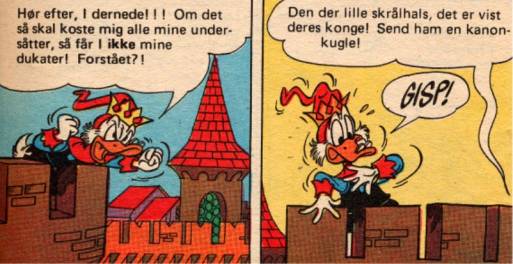
King Scrooge III in dialogue with the masses
assembled outside his castle.
Prince
Scrooge V appears in an Italian story “The treasure of the Emperor” (AT 175)
with Master Donald, three nephews and a certain Maid Annika, whose association
to the family is not yet known.
The
Ducks also had ancestors in Spain. In A.D. 1513 Ponce de
Loon, Capitán in the army of King Ferdinand of Spain, went to America to search
for the fountain of youth (US 32). According to Barks, he (Ponce de Loon, that
is) was a distant relative of Scrooge and Donald.

The
camp of Capitán Ponce de Loon somewhere in Florida 1513. In spite of the
chicken-like beak, the captain is said to be a distant ancestor of the Duck
Family.
The
Spanish nobleduck Don Pato came to Scotland riding a barrel, after his ship
‘La Dorada’ went down with the Spanish Armada in 1588, as duckumented by
Strobl in “The Golden Galleon” (DD 103).

The elegant maritime arrival of Don Pato to
Scotland in 1588.
A female descendant of Don Pato later married into the McDuck Clan. Count Scrooge of Goldania, Sir Donald, Huey, Dewey and Louie, as well as Daisy and her father Count Canardo of Silvania all appear in an Italian story (AT 160).
In
France, Donald fights his way through Paris in 1640 together with Count Scrooge
of Duckburgh, Squire Gladstone and Daisy (TL 600). Also appearing are Monsieur
Gus, a landlord, and Georg Klinge, Gyro’s ancestor, as a weapon smith.

Donald de Donaldac faces insultingly
inferior competition in the streets of 17th-century Paris.
And,
of course, together with Mulos and d’Artanmick, Andos was a ‘mouseketeer’
at the court of King Horace XIV, as duckumented among others by Strobl in “Two
Musketeers plus one” (WDC 299).
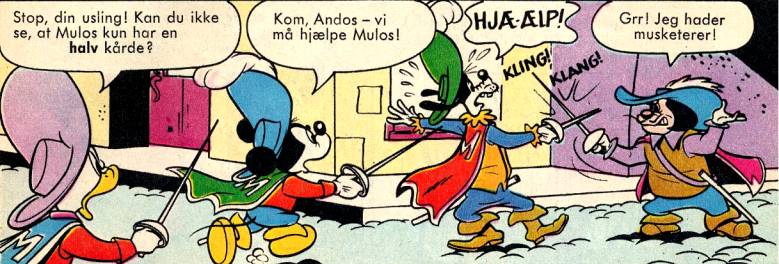
Andos, Mulos and d’Artanmick as the famous
‘mouseketeers’ of King Horace XIV and the beautiful Queen Clarabelle.
Danblane McDuck was a pirate of the Caribbean in 1631-61. Originally he was an admiral in the British navy, but his preference for herring made him plunder the aboriginal population on the islands of the West Indies, and this sealed his fate: he was doomed to haunt the airspace of all the world for about 300 years and every year to drop a load of herring over Tegucigalpa, the capital of Honduras. And this “The Flying Scotsman” is Scrooge’s great-g-g-g(?)-grand-uncle, as reported by Luciano Gatti and Romano Scarpa (TL 174-175).


Even
though the Ducks are known for their doggedness, this one probably takes the
price: Captain Danblane McDuck, more than 300 hundred years at sea and still
going strong - although also, understandably, a bit tired.
Richman McDuck fooled the ancestors of the Beagle Boys in 1713 in “The great exciting gold coup” (AA 2-3/1979). The Earl of Asketty from Scotland A.D. 1700 is also one of Scrooge’s ancestors. The present earl inherited the right to strike his own coins on equal terms with Scrooge (TL 1104).


The Earls of Asketty have held the right to strike coins ever since this privilege was given to the first earl by King Forkfether. Actually, the present (but unnamed and unnumbered) earl still has this right, if he could only find the document.
The
ship of Seafoam McDuck, ‘The golden Goose’, sunk on a voyage in 1754, by
which he lost his fortune to Chisel McSue. The only thing he kept was his golden
teeth (because he outran Chisel, who would take them away from him too), and
Scrooge inherited these teeth (OS 495).

The
sad day in 1754, when Seafoam McDuck lost his ‘Golden Goose’ - but
fortunately enough not his golden teeth.
One
of Scrooge’s ancestors founded a lichen-plantation in Lower Antarctica in 1760
according to Strobl in the story “Too Cold To Care” (DD 75). McTavish Duck
from 18th-century Augusburgh, Scotland, was related to Scrooge’s
grandfather. His motto was ‘Frugality’ and he was poor all his life. His
daughter married a Lochbert Gander, ancestor to Gladstone, which was duckumented
by Phil de Lara in “Castle Heirs” (DD 42). The late Pokerface McDuck left
Donald and Gladstone his portrait and a grandfather-clock (DD 30).

The
portrait of Pokerface McDuck. His name in Danish donaldism, Stivnakke von And
(‘Stiff-neck McDuck’), does in fact better fit his picture. In German
donaldism, he is known as Schwindolar Schwan, whom according to Dr Grobian Gans
was a possible father of Gladstone - and, furthermore, father to the mother of
Huey, Dewey and Louie! If so, ‘Pokerface’ is perhaps not the least suitable
name for him…
Of Scrooge’s great-grandfathers I have found two or maybe three: Pampero McDuck was a carpenter in the Old West in 1848, where he succeeded in getting two pounds of gold for one pound of nails. His nickname was ‘The old Wizard’, and he appeared in an Italian story (TL 690). Potluck McDuck, paternal great-grandfather of Scrooge, was a gold digger and collected old stuff, as reported in “Old Potluck’s Payoff” by Strobl (S 70086). McRapan, Scrooge’s ancestor, buried a penny in 1849 (or 1830) on ‘One-penny-island’ (TL 773).
As I mentioned in the introducktion, I have found four(sic!) grandfathers of Scrooge. Titus McDuck, Scrooge’s grandfather in Scotland, tested if Scrooge had the right McDuck-stinginess in “The Search for Cyril” reported by Strobl (DD 70). Silas Elias, Scrooge’s grandfather and Donald’s great-grandfather, left a treasure map. He was a mariner and was mentioned in “Rainbow Island Rendezvous” by Strobl (DD 41). Ebenezer McDuck, Scrooge’s paternal grandfather, bought property in 1878 where Duckburg is now located, according to “Indian Takeover” by Bradbury (S 68064). Pamfilius McDuck was a gold digger and left Scrooge a goldmine with “The golden Pumpkin”, as reported by Strobl (AA 22-23/1977). Finally, in a Barks story Scrooge told that his grandfather was a miner called McDuck (US 29), so it seems difficult to decide, who Scrooge’s grandfathers actually are, but I will divide them into two persons: Scrooge’s mother’s father, who was a miner and stayed in Scotland, and his father’s father, who left for America as a sailor and later became a gold digger. Therefore, Titus McDuck is his maternal grandfather and Ebenezer Silas Elias ‘Pamfilius’ McDuck his paternal grandfather, both ascended from the Scottish nobles of Clan McDuck.
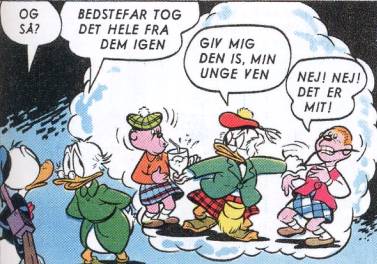
Meet one of Scrooge's four grandfathers: Titus And/McDuck, executing the traditional "one-pound-note test", which Scrooge's cousin Andy/Cyril failed miserably - to the very short-lived pleasure of his friends.
Moreover, it can be noted that Quagmire McDuck, Scrooge’s grand-uncle, left him a pocket watch that could predict eclipses, according to “Heirloom Watch” by Barks (US 10).
Of Scrooge’s uncles, I have found the following: Pothole McDuck was captain of a Mississippi-riverboat in 1870, as chronicled in “The great Steamboat Race” by Barks (US 11). Barks also knew of another aged uncle of Scrooge’s, Jake McDuck, who had borrowed some money from Scrooge 60 years ago (OS 367).

As
a duckling, Scrooge rode the knee of his Uncle Jake McDuck - and, more
importantly, later on lent him 2 Kroner.
Swashbucle Duck was a big-game hunter, whose personality was transferred to Scrooge via a portrait in “Outer Space Safari” by Strobl (DD 113). Jeremias McDuck loaned Scrooge money many years ago, and left all he owned to his fourth-cousin Johannes Gåsefod, who bestowed the IOU to Kristian Krikand, who finally transferred it to his mother’s aunt Grandma Duck (TL 582). Aunt Andedun was married to a sailor, and Scrooge, Donald, Daisy and Gladstone each inherited something from her in “The frugal Heir” (AA 52/1971). Sofie McDuck was Scrooge’s aunt and she left him two cats, which owned 150 million Kroner, as described in “Uncle Scrooge and the miaowing inheritance” (TL 366).
Of
Scrooge’s paternal cousins, I can mention Lurch McDuck, who lent Scrooge 10 Kroner
many years ago, and who therefore ought to have half of Scrooge’s fortune, but
he tired from Scrooge’s chivvying and left for Sandara, where he became rich
by oil (DD 116). MacPiper from Scotland was a gold digger like Scrooge and once
sent him “The odd bagpipe” (TL 709). Victor McDuck is a loony old guy who
sees Indians everywhere. He is not very friendly with Scrooge in “The Pipe of
Peace” (TL 290-291).


Examples
of two formerly gold-digging cousins of Scrooge. To the left: Cousin MacPiper
depicted with his beloved bagpipe. To the right: Cousin Victor McDuck with his
beloved scalp, which he eagerly wants to keep.
Gnier McDuck from Nærigkøbing had died in “The buried inheritance” reported by Vicar (AA 25/1976). Slye McDuck is from Scotland like Wee-Angus McDuck, Scrooge’s (distant) nephew, in “One for the whammy” by Strobl (DD 65).


Examples
of Scrooge’s present Scottish relatives: Slye McDuck (to the left) and
Wee-Angus McDuck (to the right).
A portrait of Adolphus Mortimer McDuck, Scrooge’s second-cousin, was seen in “The treasure in the Portrait” (AA 44/1966). Another second-cousin is Moocher McDuck, who is often mistaken for Scrooge, who does not like that, because Moocher is a vagabond (LA 2/1978). Scrooge has also got cousins who are not named McDuck, and therefore it is difficult to place them correctly in the tree. Usually, I put those with the family name ‘Duck’ on his mother’s side. Andreas is a cousin to Scrooge and Ludwig, and uncle(?) to both Donald, the nephews and Gladstone. He is a ranch owner and visited “The dear Family” as reported by Vicar (AA 41/1976). Nolle Duck became rich by manufacturing wooden spoons, but he went broke when people began using plastic (TL 567),


When Duck relatives come to town it is always exciting for the family to learn if they have been blessed with financial luck - and often it is a bit of a gamble for the hosts. In the case of Uncle Andreas (to the left), it all turns out sweet for Donald and the kids, while Uncle Nolle (to the right) is both a tiresome and expensive acquaintance.
.. and Cyril McDuck got a one-pound-note from Grandpa Titus to test, if he had the family stinginess (DD 70).

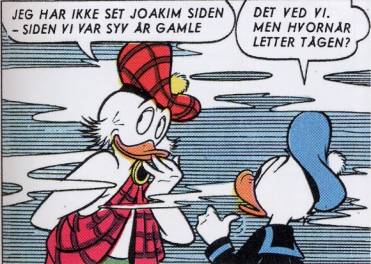
The
black sheep of the McDuck Family: Andy And or Cyril McDuck. At the age of seven,
Mazuma
Duck is the richest duck in South Andystan, and his three nephews (or sons?)
Tom, Drake and Harry all have high positions in “Getting the Business” by
Strobl (WDC 285). Moby Duck was in German Micky Maus no. 23/1977
mentioned as a cousin to Scrooge, and I reckon Dim-Witty and his son/nephew
Dimmy Duck as members of the family too, so even though there has been no direct
indications, I put Dim-Witty as Moby’s nephew. Scrooge’s cousin Rufus
Fuddleduck was a gold digger and visited him in DD 125 by Strobl. Filias
Flottenheimer was cousin to an uncle to a brother of a cousin to Scrooge’s
grandmother and grand-uncle to an aunt of Donald’s father’s niece’s
sister-in-law (TL 375).

Two
potential heirs explain their close relation to the late Filias Flottenheimer
before the probate court of Duckburg. It is noted that the honourable judge is
NOT an Owl, and, sure enough, also reveals himself as quite inadequate to handle
the case, as he turns to the in legal sense somewhat questionable solution to
decide his verdict by tossing a coin.
Scrooge’s
father has been travelling a lot. Even if he without a doubt was a Scot by birth,
he has been a sheriff in Duck’s Bluff in the Old West, going by the name of
‘Bluffer Duck’ (according to Jon Gisle in “Donaldismen”,
p. 97),
and according to Barks he bought a cannon in France after the war of 1871 (WDC
134).
Carl
Barks duckumented that Scrooge McDuck himself celebrated his 75th
birthday in US 12 (published in 1955), so even if Jack Chalker in the “Informal
Biography of Scrooge McDuck”
sets his birth year (Scrooge’s, that is) to 1860-65, I would rather go for
1870.
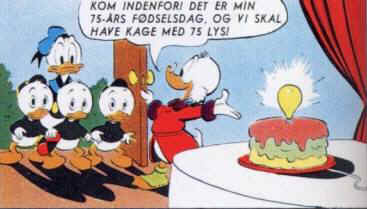
In
1955, Barks could duckument how Scrooge McDuck celebrated his 75th birthday with
a cake carrying a 75-watts light bulb. This piece of donaldistic evidence has
been given grand importance in a long, academic dispute held here at the Academy
regarding whether birthday-cake candles can be used to determine the age of
Ducks.
Scrooge’s mother was a daughter of Titus Duck and a sister to the mother of Elvira ‘Grandma’ Duck and Ludwig von Drake. Scrooge has two sisters: Donald’s mother, probably born around 1890-95, and Donald’s maternal aunt Evelyn, who left him a cat that Donald should look after for $ 1.000 a month (TL 934).
The American branch of the Duck family is probably descended from Captain D. Duck Esq., who came to Plymouth Rock, with (or rather swimming beside) the Mayflower in 1620 (drawing by Barks in Newcon no. 2). Maybe Donald inherited his clothes, because he wore a puritan outfit on a turkey hunt in WDC 87.


Captain D. Duck Esq., »..one whose ancestors swam to Plymouth Rock alongside the Mayflower...« according to Carl Barks. Did he leave his clothes and gun to later generations for turkey hunting?
Amongst statues and street signs in Duckburg, I have found several Ducks, who possibly are part of the family. Globus von And was a famous explorer (WDC 293). Robert Rapand discovered Andrik Island in 1609 (DDCA 3). In 1667, Duckburg consisted of an Indian village and a fort (AA 27/1968), but who actually founded the city is hard to tell. The statue of Cornelius Coot is shown in three different Barks stories, amongst these the famous story of the maharaja (WDC 238). Dwight Duck’s statue was made in AA 27/1960, Penwick Duck’s statue was shown in DD 111, and last was Albert Andriksen mentioned as city founder in “The fabulous Fixer” by Strobl (S 68210); actually, this again was a mistranslation, it seems to be C. Coot here too, in his first non-Barks appearance.


Globus von And was a famous discoverer originating from Duckburg, and his native city honoured him by naming a street after him; to judge from his name (“Globe McDuck”), he is likely to be a relative of Scrooge’s. Another famous fellow-townsduck was Albert Andriksen, who apparently helped Cornelius Coot founding Duckburg - if it is not indeed a cover-name for Mr Coot himself. However that may be, he generously gave his city a wonderful piece of mechanics: a combined roundabout and steam organ.
George
O’Duck’s portrait was shown in AA 42/1962. Three generals from the American
civil war are also shown as statues: General Stonewall Duck (WDC 239), General
Krikand (AA 38/1962) and General Fladnæb (WDC 293).
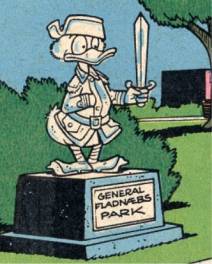
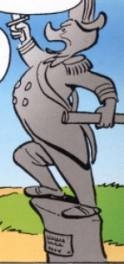
Examples
of Ducks making it to the top in Duckburg’s military history: General Fladnæb
(“Flatbeak”) and General Stonewall Duck.
Uncle
Adrian And warned Fort Duckburg against an Indian assault, and his statue was
shown in AA 25/1968. The Ducklings’ great-g-g-g-g-grandfather Crockett Duck
chopped his way through the wild forests of Canada (DD 3). Grandma’s great-grand-uncle
Asa Duck left her his diary, while Scrooge got his pirate gold (DD 139). An
ancestor (Grandma Elvira’s grandfather?) was an officer in the civil war.
Donald inherits his clothes, which he wears in a Taliaferro strip (ZD 43-12-26).

During
the general mobilization of Duckburg in 1943, Donald digs out an old officer’s
uniform in order to better fit in with the military milieu of the town. Possibly,
the uniform originally belonged to one of his ancestors.
Grandma’s
grandfather got designs made of a ‘Windmill-scarecrow’ (DDCA
3.) Her grandmother too had lived on the farm, which was built by Uncle Grånæb,
who was also a gold digger (S 74198).

The
farm of Grandma Duck was built by her Uncle Grånæb (“Greybeak”). He was
also a gold digger, and he hid his gold in the weirdest places, from where it
still pops up from time to time.
Andtonius
And, Grandma’s uncle, was a ships-captain, born in 1853 and died 1937 (AA
45/1964). Uncle Jake was a sailor, from whom Grandma inherited a locker he had
brought with him on his voyages in forty years (OS 586). Grandma’s cousin
Skovmand gave her a buffalo (DG
55).
Kitty is Grandma’s cousin and rather arrogant (AA 41/1974). Grandma’s father
was a farmer, and her mother was probably a sister of Scrooge’s mother,
because Grandma once inherited a recipe from her mother, which just as well
could have been Scrooge’s (AA 2/1969) - and Ludwig von Drake’s.

Grandma
Duck tells Gus about the blizzard they had, when she was a little girl back in
1898. In an older version of the story, she dates the blizzard to 1888. Is this
another example of erroneous translations - or just a case of Grandma’s shaky
recollection? When old people tell and retell stories like that, the details do
tend to change…
Grandma
states that she was a little girl in 1888 (WDC 161), but she was at a harvest
ball with Humperdink in 1904 (VP 2), and if she is grandmother to Donald, who is
born about 1920, she must have been born about 1880 at the latest, which fits
fine with the fact that she in AA 4/1952 has used a broom for the last 60 years.

Grandma
Duck reliving a romantic moment: her dance with Humperdink at the harvest
festival in 1904. The tune is of course the old classic “When you and I were
young, Ernestine”.
Grandma’s
sister married a Goose and became mother to Gus Goose (VP 1), therefore Gus
is a cousin of Donald’s father rather than of Donald.

The
genealogical reason why Grandma Duck has not fired Gus a long time ago: he is
her nephew! Of course, Dr Grobian Gans has also suggested a rather alternative
sexological reason...
‘Moss’ is Gus’ cousin. In the story ‘The road to wealth’ by Strobl (AA 47/1965), Scrooge’s servant, here called Gus, says »…my cousin ‘Moss’ and I have both served the Duck family through many generations.« (sic!). As is well known, Gus ‘works’ at Grandma’s farm, so it is reasonable to assume that there is a mistake either in the American manuscript or in the Danish translation, so that Scrooge’s servant is Moss and not Gus. Another of Grandma’s sibling’s daughter has married a certain Krikand and become mother to Kristian Krikand, who inherited a debt from Johannes Gåsefod, who again had inherited it from his second-cousin Jeremias von And (TL 582).
Ludwig
von Drake and Daisy’s family
In German Micky Maus (MM 5/1965) it is mentioned that Grandma Duck’s maternal aunt married a certain Hofrat von Drake from Vienna, and one of their children is Ludwig von Drake, who therefore is Elvira’s cousin. In AA 33/1962 it is told that Ludwig is Donald’s uncle on his mother’s side, and because Elvira is Scrooge’s cousin as mentioned in VP 4, Ludwig must be Scrooge’s cousin too. In “Die Ducks”, Grobian Gans pointed out that Ludwig is Daisy’s uncle, because she is the only one who calls him that (in German); even Donald mostly calls him ‘Professor’. While Daisy’s surname is Duck, Daisy’s mother must be Ludwig’s sister because of the changed surname.


An academic ideal to us all: Professor Ludwig von Drake. It is truly impressive how many doctorates in practically anything this Austrian-born Duck has to show - and so eagerly likes to show at any given opportunity. His exact relation to the rest of the Duck family is less clear, but no matter how closely related, the professor is - according to himself in usual humility - an “expert on good influence on bad Ducks”.
In
the Barks story WDC 111, on the second to last page, we see an elderly lady, who
evidently lives with Daisy. In my opinion, this must be Daisy’s mother. She
has probably died or just left shortly after, for she has not been seen since.

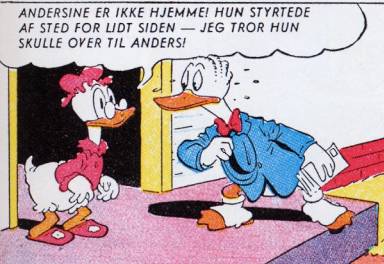
Who is that nice little old lady, who lived with Daisy in 1949? Could this be the only extant picture of Daisy's mother? And, thereby, the grandmother of April, May and June? No wonder if Gladstone looks excited.
In “Winning Ways” (LvD 1), Ludwig mentions that he had an aunt in Vienna, and in the same story, he mentions a sick uncle. A brother of Ludwig must be father to Daisy’s cousin Pierre, a Parisian pastry-baker (AA 48/1968) and Cedric Canvasback, who is a railway tycoon descended from a famous count (DD 30).

The sligthly excentric railway manager Cedric Canvasback is a cousin of Daisy and - according to a genealogist hired by Daisy - a nobleduck descending directly from 'the Bald Count', a notorious character known from Danish medieval history.
Daisy’s great-great-grandfather was called Pamfilius Duck. Any connection with Scrooge’s grandfather Pamfilius McDuck is doubtful, but together with Scrooge’s father, he owned the trading company “Duck & McDuck” (CPGK 1). Daisy’s grandfather wore a walking stick and a high hat (AA 13/1968). He and his wife had several children: Daisy’s father; Aunt Tizzy, whose father (Daisy’s grandfather) won a donut-eating competition in 1946 (DD 114); Aunt Tarzania was “A Relative Problem” according to Bradbury (AA 49/1964) and very strong for her age, she was married to Olfert, who was strong man in a circus; Aunt Matilda in Swantown (WDC 204); and one of the parents to Daisy’s cousin Gertrude, who is a Goose and paints flowers (ZD 41-07-06).

Daisy's cousin Gertrude is a Goose and a very skilled artist, who offers to paint Donald's car significantly cheaper than at the local garage. Still, for some reason, Donald does not seem completely happy with the result...
Daisy Duck has at least two siblings. In the ‘Flip-ism’ story by Barks (WDC 149), Daisy visits her sister, the mother of April, May and June, while Daisy’s nephew Desmond is shown in a story by Gregory (GH 32).


Out in the scruffy suburbs of Duckburg lives Daisy’s sister. We do not see her or learn her name, but her daughters are well known: April, May and June. Academic donaldism has seen numerous interesting suggestions as to whom their father might be, where several indications point to a Goose - and a social scandal...
Daisy’s godfather and rich uncle J.P. van Duck was mentioned in WDC 220 by Strobl, but his relation to the family is unknown.
Grandma
and Grandpa Duck’s line
Grandpa
Daniel was a sailor and warned Duckburg about the storm surge of 1878 in “The
Giant of Duckburg” (DD 111). He was probably Donald’s great-grandfather and
Grandma Elvira’s father-in-law. In the story, two elders of the Duck Clan also
appeared, maybe Elvira’s brothers-in-law, and a statue of Duckburg’s founder
Penwick Duck(!). Gumboot Duck was the duckling’s grandfather’s grand-uncle
and a mailman in Alaska 1897. Their grandma’s uncle’s second-cousin
Panhandle Duck once was pursued through the desert by a tribe of Indians. And
Donald’s aunt’s aunt’s cousin used to spend his days all alone in the
great forests. All three of them are known from a story by Bradbury (DD 30). Olle
Duck, Donald’s grand-uncle, left him an orange plantation, which went to
Gladstone instead (JB 24).
Grandpa Duck appeared in a story by Strobl (DD 93), where Donald remembers him as very lazy, which (well, maybe Donald remembers wrongly) might be because Grandpa was son of a sailor and therefore not used to the country life in contrast to Elvira, who was raised on the farm. In VP 2, she reveals that in 1904 she went to a harvest ball with Humperdink, who probably is identical with Grandpa (even though she danced with a guy named Theodor in 1910 too). In OS 1150 she lets Daisy know that she has not cried in 20 years, and I think this indicates that her husband died shortly after Donald’s film debut, about 1940.


In a story duckumented by Barks in 1960, Grandma Duck reveals that she has not cried in 20 years. Could this indicate that Grandpa Duck died around 1940? Or just that her tear canals have dried out?
Donald Duck himself is son of Scrooge’s younger sister and Elvira’s oldest son. In the cartoon “The Little Wise Hen” from 1934 he seemed very young, but in 1936, when he appeared in the comic strip “Silly Symphonies” by Al Taliaferro, he seemed quite grown up - at least he lived alone and was old enough to take care of his three little nephews. In YD 1947-06-10 we are informed that he went to school in 1935, so I reckon, he is born (or hatched) about 1920, which fits well with a father born about 1900, and his mother can easily be 20 years younger than her brother Scrooge. Donald’s parents died before he was 5 or 6 years old, and thereafter he moved to Grandma’s farm. He did not care for the hard work, though, and moved away from home as soon as he could make it on his own.
Several
times, we have been told that Donald is Scrooge’s closest heir, and therefore
he cannot have any cousins, aunts or other uncles but Scrooge on his mother’s
side. The following family members have to be on the paternal side for that
reason, and they are descendants or in-laws of Grandma Elvira: Donald’s father
has not been mentioned anywhere (except in a very obscure source: an obituary in
a MAD-Magazine from about 1967, where he is called Exeter Duck, Donald’s
mother is called Mamie), but of his brothers we know a few: Hannibal Duck died
and left Donald his house with a hidden treasure (TL 751); Rich Duck dug for
gold with Scrooge and left Donald his part of a mine (AA 7-8/1966); and Upsy
Duck was a mountain climber and climbed the Strato Peak, but could not climb the
little mountain Matterhorn (WDC 293).

The
famous and fabulous mountain climber Upsy Duck in a traditional mountainous
outfit - and a for his family equally traditional sharp look in the eyes.
Some
of Donald’s uncles we know only by their first name, so it cannot be
determined if they are brothers to his father or married to his aunts: Andreas
was an admiral in AA 33/1969; Uncle Eider sent Donald the falcon Farragut (WDC
47); and finally we have Uncle McWaddle, who left Donald a house (WDC 115).
Neither can Donald’s aunts be divided into sisters of his father and in-laws.
Adriane in Australia sent him the young kangaroo Milton (AA 46/1976); Deborah
sent him a knitted sweater (YD 50-01-26); Drusilla went with her daughter Petra
(actually it was her niece Daisy) on a cruise in Barks’ last story before he
retired (WDC 312).

In the last days of Late Barksism, many established traditions of Duckburg begin to crack. Daisy performs as a sexy model, Gladstone grows himself a goatee and an afro, and Donald does his best to impress his Cousin Petra (and to a less extent Aunt Drusilla) by reciting seaman’s poetry and shooting down an albatross with bow and arrow.
And
so, we have reached Donald’s cousins. Besides Petra we have Nancy Duck, who is
an apprentice news-photographer (DD 148), and Della Duck, who is the mother of
Huey, Dewey and Louie Duck. Their father, Della’s husband and Donald’s
brother(?), got sick and died after the ducklings had fired a giant firecracker
under his chair. In their first appearance in 1936, the nephews do not talk very
much and ride tricycles, so I do not reckon them more than 3-4 years old,
probably born around 1932-33. Their mother Della must have been very young, when
she had them, which might explain why she could not handle them herself.

“The
Letter”: the probably single most famous object of donaldist-scholarly
attention throughout history.
Donald’s
male cousins are innumerable. Fethry Duck showed up for the first time in DD 105
in a duckumentation by Strobl.

The introducktion of Fethry Duck. If Donald had known what this cousin would bring of tremendous trouble, his initial greetings in Duckburg Airport had probably been less friendly.
Fethry
is not related to Daisy, whom he meets for the first time in “Suds in Your
Eyes” by Kinney and Hubbard (S 64123), which is why I have placed him among
Donald’s other cousins. Dietbald Duck is a lumberjack in one of Scrooge’s
forests (AE
6/1978).
Whitewater Duck is a lumberjack too, but independent, and he makes Donald help
him rafting lumber (WDC 267).

The rugged Whitewater Duck is not the nicest of Donald’s cousins, but in his defence, it should be said that a big timber log has hit his foot just before the cousinly meeting.
Daniel
Duck is sheriff in Western City and appears in two different stories:
“Daredevil Deputy” by Bradbury (DD 61), redrawn by Vicar in AA 18/1978, and
in a story by Strobl in DD 70. Besides that, he maybe appears as Dristian Duck,
Donald’s second-cousin in DD 131.

Daniel (or just ‘Dan’) is one of Donald’s older cousins. His is the sheriff of the small town Vestenby - a place of apparently rather liberal legislation in regards of gun possession.
Dudley
D. Duck is an unfortunate inventor, who has constructed Break Tunnel and a
water-repelling paint (DD 136). Fritz, Flink and Landy are all farmers. Fritz
tends his farm like Grandma Duck does (S 63051), Flink remembers his youth with
Donald (S 63111), and Landy is married to Molly with at least four children: two
boys and two girls (S 71377). Cousin Andrik is shown in a story about a lost key
(AT 782). Cousin Botcho (DD 31) and Cousin Marmaduke (DD 28) are both crazed
inventors and maybe brothers.
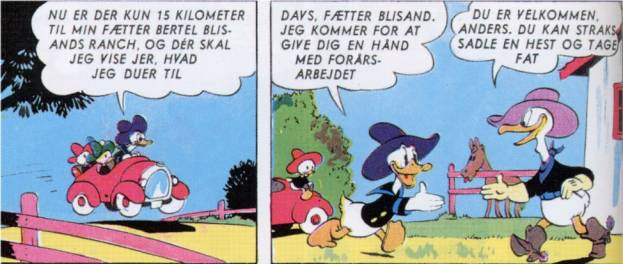
Donald has got several cousins living in the rural hinterland of Duckburg. Among these, we meet Cuthbert Coot, who not only owns a ranch with a very vicious horse, but furthermore is the living proof of a genealogical relation between the families Duck and Coot.
Cuthbert
Coot owns a ranch (WDC 55), Dali Duck, Donald’s second-cousin in Australia, is
a famous boxer (AA 21/1974), and Dristig, Sherlock and Cosmo Duck together with
14 other cousins and/or uncles appear at the annual Duck-family reunion in
“The Overnight Hero” by Strobl DD 91.

Cousins in numerous numbers present at the annual feast for the Family Duck. For donaldists with oftamological interests, it is quite noteworthy how all the cousins - with the detective and the diver as possible exceptions - have small eyes with no beak-attachment just like Cousin Gladstone. Could this be an indication of a more widespread amount of goose blood in the Duck Family than usually supposed?
Champion, uncle to Donald or maybe the ducklings, may be an explorer, as he sent them an ape from Orang-Utanga (AA 18/1974). Zak McWak, the duckling’s uncle, invented a spray against worms in apples (DD 119). Featherbrain Duck accidentally bought the completely useless Crater Swamp at an auction in “Showdown At Smoky Acre” (DD 149). And finally, Anna-Lina Duck is an aunt to someone in the inner family, who sent Daisy and Donald an ugly vase each (AA 10/1976).
As
mentioned under Scrooge’s ancestors, a son of Nikolas Gander (a Danish
translation error) called Lochbert Gander married the daughter of McTavish Duck
once in the 1700s (DD 42). A Sir Gladstone Gander of 19th-century
Basketville appeared in “The Hound of Basketville” by Strobl (WDC 300). His
ancestor of a century earlier, the late Sir Crabstone Gander, is mentioned too.


Meet Sir Gladstone Gander: Count of Basketville, superstitious, and fond of tomato soup. To the right: his ancestor Sir Crabstone Gander, also Count of Basketville, and actually carrying the basket.
Miss Susiebelle Swan, Gladstone’s distant aunt, lived at least from 1856 to 1901. Gladstone inherited a letter with a valuable stamp in a story by Barks (OS 423).
In
the introducktion, I mentioned that Gladstone in “Race to the South Sea” by
Barks (MOC 41) said that Scrooge was his mother’s brother’s brother-in-law.
Combined with the fact, that Scrooge is Donald’s uncle on his mother’s side
(which is mentioned in the same story), and Donald and Gladstone are cousins,
this means that Gladstone’s mother is Donald’s father’s sister, and
thereby a daughter of Elvira. Gladstone’s father is a Gander, even if there is
some Duck- and Swan-blood in his family, but Gladstone is clearly more Duck than
Goose. Finally, Gladstone has a brother, who is the father of Shamrock and two
daughters (OS 649).
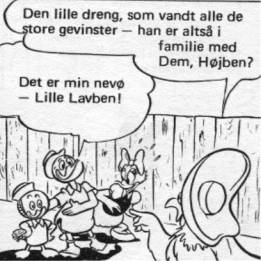

The next generation of Ganders: Gladstone’s nephew Shamrock and two young female Ganders (sic!).
This was my model of the Duck-McDuck family tree. Surely many donaldists will disagree with me in many points. I excuse the tree and the article not being complete with my limited access to source material in Danish and certainly in the original languages too. Please observe, that the work with this article and tree was finished several years before Don Rosa made his Duck family tree, which was printed in many countries, and that it therefore does not agree with it in all points; but the reader is free to see Ande-Aner as an illustration of, where the donaldistic genealogy stood 20 years ago, or to see it as an equally valid (or invalid) bid on the Duck family tree. Don Rosa has as an official comic artist deservedly been able to get his tree presented as canon (no Frank, not the cannon that Scrooge’s father bought after the war); but I would be happy if other donaldists would bring the tree up to date or even put forward the ‘united field-theory’ of donaldistic genealogy (which perhaps already can be found on Gilles Maurice’s Calisota Online-page).
I would like to thank everyone who has helped me with research: Frank Madsen, who put a great work in transcribing my manuscript, Tommy Andreasen, Niels Petersen, Rune Kidde, Martin Hagstrøm, Hans von Storch, Christian Baron, Werner Dwenger, Martin Wimmel, Jon Gisle, all earlier donaldistic genealogists and the contributors to DAFI’s library. A special thanks regarding my translation into English to the Inducks COA-crew, without them the article would be an unreadable listing of Danish name-translations and publications.
This
dissertation was accepted in January 2006 by The South-Nordic Academy of
Donaldism (SAD)
for
obtaining the academic-donaldistic ducktor’s degree (Dr.don.).

Source
abbreviations (used
in text and emerging when cursor is placed over picture):
|
|
Literature:
Chalker, Jack L. (1974): An Informal Biography of Scrooge McDuck.
Gans, Grobian (1970): Die Ducks - Psychogramm einer Sippe, München.
Gisle, Jon (1973): Donaldismen - En muntert-vitenskapelig studie over Donald Duck og hans verden, Oslo.
|
|
|
|
Sydnordisk Akademi for Donaldisme henleder opmærksomheden på, at rettighederne til (næsten) alle de anvendte billeder på Akademiets sider tilhører ©Disney, der i Danmark er repræsenteret ved Egmont Serieforlaget A/S. Billedmaterialet må ikke anvendes i erhvervsmæssigt øjemed.